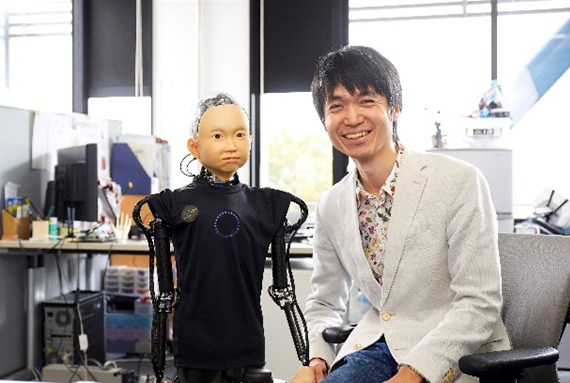September 2021 Issue
Topics
Creating robots to coexist in harmony with humans in the real world
Yoshihiro Nakata,
Associate Professor, School of Informatics and Engineering, Department of Mechanical and Intelligent Systems Engineering, UEC Tokyo.

“The is extensive research on autonomous robots and androids that look and behave like humans”, says Yoshihiro Nakata, an associate professor at the School of Informatics and Engineering, UEC Tokyo. “Ultimately, in order for robots to become an integral and functional part of modern society, they must be able to move freely within everyday social settings alongside humans, without danger or concern. The key to realizing such a society is for robots to be able to “gently interact” with humans without the unnatural rigid movements associated with conventional robots. To achieve a society of “gentle robots” it is necessary to develop new generations of actuator technology. This is the goal of my research. Namely, to develop actuators for powering “gentle and socially acceptable robots.”
Nakata’s research can be divided into three types: actuators, mechanisms, and humanoid robot research. In actuator research, Nakata and his colleagues have focused on making actuators that mimic the flexibility, power, and agility of human muscles, with the goal creating machines with a gentle touch.
Research on mechanisms he has been trying make a “body that can tolerate various forms of contact from the environment and “feel” the force not via joints but by the whole body—the goal is to create machines that gently feel such forces.
The third is research theme is on humanoid robots, with the goal of creating robots that can be part of the natural world without feeling the burden on people in society.
“I started research on actuators when I was an undergraduate student,” says Nakata. “For flexibility and agility, I developed linear motors as actuators for robots. And since linear motors do not have an intrinsic deceleration mechanism and is direct drive, it is possible to devise actuators with flexibility against external forces, with high response and high accuracy by driving with electromagnetic forces.”
Now, since moving to UEC Tokyo in March 2021 Nakata has defined three goals for this research for the development of robots that behave in a human-friendly manner in the real world.
“My research in really challenging because it’s necessary to carefully study the behavior of both robots and humans,” says Nakata. “Ultimately, I want to realize an advanced intellectual system by understanding human behavior and applying it to robots, and aim for a deeper and more essential understanding of humans.”


